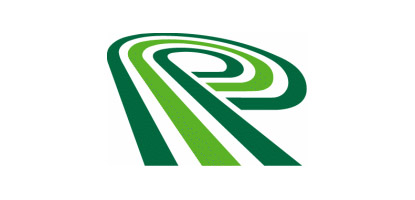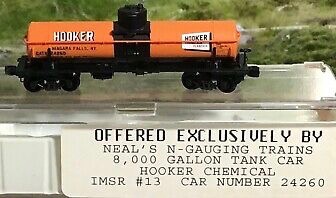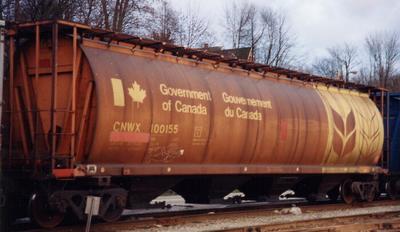Model Information: These models are available in two different configurations - "Trough" hatches or "Round" hatches. Prior to their more recent "Ready-To-Run" state, they were available in kit form. Intermountain doesn't actually specify a prototype for this model, but it appears to be based on an NSC (National Steel Car) 4750 cf hopper.
Prototype History: ACF introduced their roundish cylindrical hoppers in the early 1960s. The cars differed greatly from the ribbed sided hoppers of the era. They have been made in 3-bay and 6-bay variations. These cylindrical hoppers were superseded on ACF’s production line by the Centerflow in 1964, a revolutionary design that influenced later covered hopper types. In the late 60s or early 70s Canada came out with 4-bay covered hoppers that appear to be derived from ACF’s pre-Centerflow cylindrical hoppers. These cars were used by CN, CP and various smaller Canadian shippers. There is some question as to why the Canadian builder based their design off the older cylindrical and not ACF’s newer Centerflow. It was likely a patent issue and copying it could have triggered legal action against the Canadian builders. There are also certain structural design differences between the cylindrical and centerflow cars and perhaps the decision to copy the cylindrical was based on the greater volume capacity of the cylindrical design.
Road Name History: The initial public offering of Potash Corporation of Saskatchewan Inc. occurred on November 2, 1989 on the Toronto (at CDN $18.00 per share, pre-splits) and New York (at US $15.125 per share, pre-splits) stock exchanges. The company had been a Crown corporation owned by the Government of Saskatchewan.
The company is a Canadian corporation based in Saskatoon, Saskatchewan. The company is the world's largest potash producer and the third largest producers of nitrogen and phosphate, three primary crop nutrients used to produce fertilizer. At the end of 2011, the company controlled twenty percent of the world's potash production capacity, two percent of nitrogen production capacity and five percent of phosphate supply. The company is part-owner of Canpotex, which manages all potash exporting from Saskatchewan. It also has a joint-venture with Sinochem named Sinofert. In late 2013, it was 60%-owned by institutional shareholders. In 2007, the CEO, William Doyle was by far the highest earning CEO in Canada, earning over $320 million.
The company is a Canadian corporation based in Saskatoon, Saskatchewan. The company is the world's largest potash producer and the third largest producers of nitrogen and phosphate, three primary crop nutrients used to produce fertilizer. At the end of 2011, the company controlled twenty percent of the world's potash production capacity, two percent of nitrogen production capacity and five percent of phosphate supply. The company is part-owner of Canpotex, which manages all potash exporting from Saskatchewan. It also has a joint-venture with Sinochem named Sinofert. In late 2013, it was 60%-owned by institutional shareholders. In 2007, the CEO, William Doyle was by far the highest earning CEO in Canada, earning over $320 million.
Brand/Importer Information: InterMountain was founded in 1985 by Fred Brummet. They got started in the model railroad business by producing O-Scale model kits. They got started in the N Scale business almost a decade later when in 1994 they introduced the 40-23 reefer car in kit form. Later, in 1998, they started producing RTR (Ready-to-Run) models. By the early 2000s, InterMountain phased out kit production in favor of the RTR models.
The InterMountain Railway company is located at 1224 Boston Ave in Longmont, CO. They are a manufacturer of HO, N and Z scale model trains. They have produced kits as well as RTR (Ready-To-Run) models. Their N Scale products include locomotives as well as rolling stock. Their rolling stock lineup includes Boxcars, Hoppers, Tank Cars, Reefers, Gondolas, Stock Cars and Flatcars.
Their locomotive releases have primarily been diesel units, with the one major exception being their series of AC-12 Cab Forward steam locos. Their diesel lineup includes F3's, F7's, F9's, SD40's, SD45's and FT units. They are known for quality and detail. They also release their rolling stock in larger varieties of road numbers than most of the other manufacturers.
The InterMountain Railway company is located at 1224 Boston Ave in Longmont, CO. They are a manufacturer of HO, N and Z scale model trains. They have produced kits as well as RTR (Ready-To-Run) models. Their N Scale products include locomotives as well as rolling stock. Their rolling stock lineup includes Boxcars, Hoppers, Tank Cars, Reefers, Gondolas, Stock Cars and Flatcars.
Their locomotive releases have primarily been diesel units, with the one major exception being their series of AC-12 Cab Forward steam locos. Their diesel lineup includes F3's, F7's, F9's, SD40's, SD45's and FT units. They are known for quality and detail. They also release their rolling stock in larger varieties of road numbers than most of the other manufacturers.
Commissioner Information: Brooklyn Locomotive Works was a hobby shop, specialized in N-scale, located in Manalapan, New Jersey, that also sells on-line. BLW regularly commissions special runs.
The company was founded by Pete Postel who announced that he would retired by end of 2018. His brother Paul should continue the business from his own shop Hogtrainz.com.
Brooklyn Locomotive Works (BLW) released special runs from various manufacturers under its own brand until approx. the mid-1980s. Thereafter the special runs where sold under the manufacturer's name and denoted as special runs for BLW. Hence in this database, we assign the BLW brand in the former case, and the original manufacturer's brand in the latter.
The company was founded by Pete Postel who announced that he would retired by end of 2018. His brother Paul should continue the business from his own shop Hogtrainz.com.
Brooklyn Locomotive Works (BLW) released special runs from various manufacturers under its own brand until approx. the mid-1980s. Thereafter the special runs where sold under the manufacturer's name and denoted as special runs for BLW. Hence in this database, we assign the BLW brand in the former case, and the original manufacturer's brand in the latter.
Item created by: Jenna on 2018-04-07 19:18:14. Last edited by gdm on 2020-05-27 14:39:03
If you see errors or missing data in this entry, please feel free to log in and edit it. Anyone with a Gmail account can log in instantly.
If you see errors or missing data in this entry, please feel free to log in and edit it. Anyone with a Gmail account can log in instantly.












